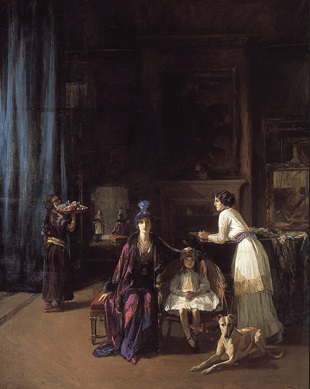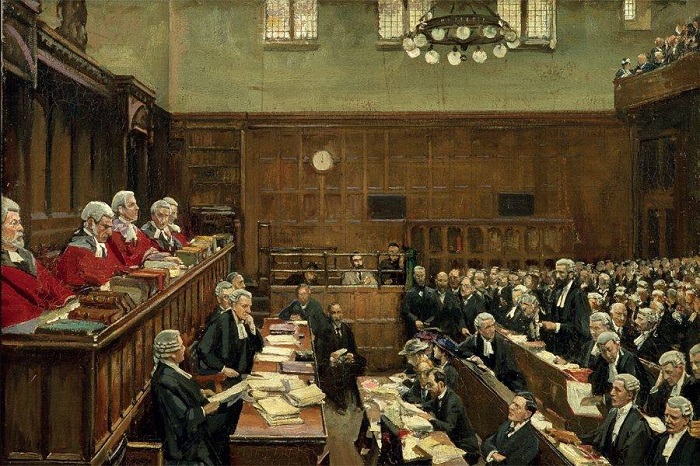Life
| 1856-1941; painter, b. Belfast; son of impoverished Catholic publican who drown when he was three; raised by relatives nr. Moira, Co. Down; ed. Magheralin Church of Ireland National School; moved to relatives in Glasgow, 1865; ed. Glasgow School of Art, and Academie Julian; influenced by Whistler; his ‘Tennis Party’ was bought for Munich from the RA show, 1886; uninterrupted success as portraitist following Queen Victoria’s State Visit to Glasgow Exhibition in 1888; m. Hazel [neé] Martyn, 1910 - at that time [of meeting] married to Edward Livingston Trudeau Jr., a young clinician who died shortly after; also conversation pieces such as the Casement trial; knighted 1918; elected to RHA, and other academies; |
| Lady Lavery became the model for the Irish banknote designed by him that remained in currency from 1928 to 1977; issued an autobiography as The Life of a Painter (1940), which incls. 69 photo-engravings of his work; diminutive in stature and tolerant of his wife’s romantic infidelities - which reputedly included affairs with Michael Collins during the Treaty negotiations in London and Kevin O’Higgins during the Civil War and after; he painted Collins both uniformed and laid out in state; painted his own wife on her death-bed (from cancer) in 1935; his oil-painting “The Green Sofa” sold at Sotheby’s for $1,314,500 on 8 Nov. 1012. ODNB BREF DIB DIH DUB OCIL |
[ top ]
| Irish Portraits by Lavery include: | ||||
|
[ top ]
Criticism
|
|
[ top ]
Commentary
Sinéad Mic Cumhaill, Hazel Lavery, A Life (Lilliput 1995), 320pp.; records, b. Chicago; went to France for artistic reasons; m. John Lavery, her senior by 30 years; setlted in London; house at Cromwell Place frequented by Shaw, Churchill, Lecky, T. P. O’Connor, Beresford, and Shane Leslie; later by Ramsay McDonald and Evelyn Waugh; Lavery’s led to Dublin by interest in politics; London house used to host Anglo-Irish conference, 1931; Lady Lavery had an affair with Collins, which she continued after the outbreak of civil war; ‘found passion with Kevin O’Higgins’, also murdered [assassinated]; greatly depressed by de Valera’s dismantling of Treaty; survived by a dg., Alice; large cache of papers.
Frank McNally, ‘Goodbye to the Pound’, in The Irish Times (2 Jan. 2002), writes of Lady Lavery, dg. Edward Jenner Martyn, descendant of the Galway family in a branch that early emigrated to America; known as ‘most beautiful girl in the mid-West’, married and divorced and jilted by second fiancé; visited Ireland with Lavery in 1913; changed her birthday from 14 March to 17 March [St Patrick’s Day] and styled herself ‘a simple Irish girl’; d. 1935, of tuberculosis [TB]; object of devotion to Michael Collins and Kevin O’Higgins, the former dying with a letter addressed to ‘Hazel dearest’ in his pocket; she was the model for the figure of Ireland on the banknotes printed from 1928; Ernest Blythe asserted publicly that the figure ‘does not bear the slightest resemblance to her’; The Irish Times, arguing the point, printed a studio portrait (supplied by her), together with a copy of the note and was prosecuted under the Forgery Act; Thomas Bodkin, in his capacity as a member of the committee, wrote to her: ‘Their award would probably favour a portrait of some farmer’s daughter. They are men of business but, emphatically, not men of taste. I know them all.’; Lady Lavery wrote back, ‘Do find out if the fat female symbolical figure of Erin in the watermark is a portrait of the late Mrs Hogan’ [i.e., the Italian wife of the Irish sculptor]; Shane Leslie, who comforted her at the death of Collins, later wrote: ‘[It is] quite impossible to tell if Haxel’s correspondence with those Irishmen Collins and O’Higgins were published or even their relations were truly portrayed there would be woe in Dublin and much protestantion. Both were hopelessly in love with Hazel, in the style of Tristram with the wife of King Mark, because they had drunk a poisonous drug not intended for them. The Republicans intercepted her letters to Collins and decided to shoot them both’. (pp.9-11.)
The Slate (21 Feb. 2003), ‘The Freedom of the City’ [“Spaz Guide” column]: ‘After independence, things opened up slightly, and sure-fire ways of securing the credit [i.e., freedom of the city] included donating extravagant amounts of valuables to the city (Sir Hugh Lane, Sir Alfred Chester Beatty) or letting most of the Free State government shag your wife (Sir John Lavery).’ (p.14.)
Terry Eagleton: ‘[...] John Lavery’s “An Irish Girl”, reveals a melancholic young beauty, pensive and high-collared, her green scarf gently catching the light and reflecting her green topknot. Lavery married the model, who told him she was Irish but turned out to be Welsh.’ (See Terry Eagleton, review of “Conquering England: Ireland in Victorian London” [exhibition], in Times Literary Supplement, 1 April 2005, q.p.)
[ top ]
References
Brian de Breffny, ed., Ireland: A Cultural Encyclopaedia (London: Thames & Hudson 1982), calls him leader of Glasgow School, he enjoyed considerabel success as a London portrait painter, knighted in 1918; Pres. Royal Society of Portrait Painters, MRA, and RHA, as well as academies in Rome, Antwerp, Milan, Brussels, and Stockholm. Sympathetic to Irish Independence, he produced pictures of the ‘Trial of Casement’, and the lying-in-state of Terence MacSwiney. Designed Irish banknotes, portraying his American wife Hazel as the emblematic figure [1923; and see col. plate in Illustrated History of Ireland (1989), p.304 facing]; returned to Ireland and d. near Kilmoganny, co. Kilkenny. He published an autobiog., The Life of a Painter (1940); see Walter
Shaw-Sparrow, John Lavery and His Work (1911).
Henry Boylan, A Dictionary of Irish Biography [rev. edn.] (Gill & Macmillan 1988), son of poor Belfast publican who drowned when he was three; apprenticed by Scottish relatives to painter-photographer in Glasgow at 17; ‘Tennis Party’ at RA in 1886 was bought for Neue Pinakothek, Munich; hon. degrees QUB and TCD; paintings include Roger Casement trial; Terence MacSwiney lying in state, and conversation pieces of George Moore and Ramsay Macdonald. His wife on banknotes from 1928.
D. J. Doherty and J. E. Hickey, A Chronology of Irish History since 1500 (Gill & Macmillan 1989, includes an article on Hazel Lavery; b. Chicago; m. Sir John, her second husband, 1910; friends were Shaw, Birkenhead, Winston Churchill; formed close friendship with Michael Collins; Kevin O’Higgins suggested Lavery as Gov.-General so that her talents as hostess could be shown.
 |
| Lady Laverty at Home |
[ top ]
Notes
T. P. Flanagan, review of Kenneth McConkey, Sir John Lavery (Edinburgh: Canongate Press 1993), 256pp. ill., in ‘Summer Books, Fortnight (July/Aug. 1994),pp.9-10, notes that Lavery came from a middle-class Catholic family on shores of Lough Neagh; orphaned and raised by an uncle on Co. Down farm, and attended Protestant school.
Note that Lady Lavery is the model for the Blessed Virgin [Mary] in St. Patrick’s Chapel, Donegall St., Belfast. St. Patrick and St. Brigid were modelled by his daughter Eileen and his step-daughter Helen respectively. (See St Patrick’s Chapel - video tour > online.) The Gothic Revival St Patrick’s was designed by Timonthy Hevey and Mortimer Thomspon and consecrated in 1877, being only the second Catholic church built in the city since the Reformation.
Sale Prices: “The Spanish Coast from Tangiers” sold at Christie’s auction in August 2003 for £251,650 [E350,800](see Irish Times, 17 Aug. 2003). Lavery’s oil port. of Lady Evelyn Farquhar, dg. of fifth Earl of Donoughmore a pro-Home Rule Irish peer - was sold in auction by Sotheby’s for £748,000 in May 2007 (see Irish Times, 10 May 2007).
[ top ]
